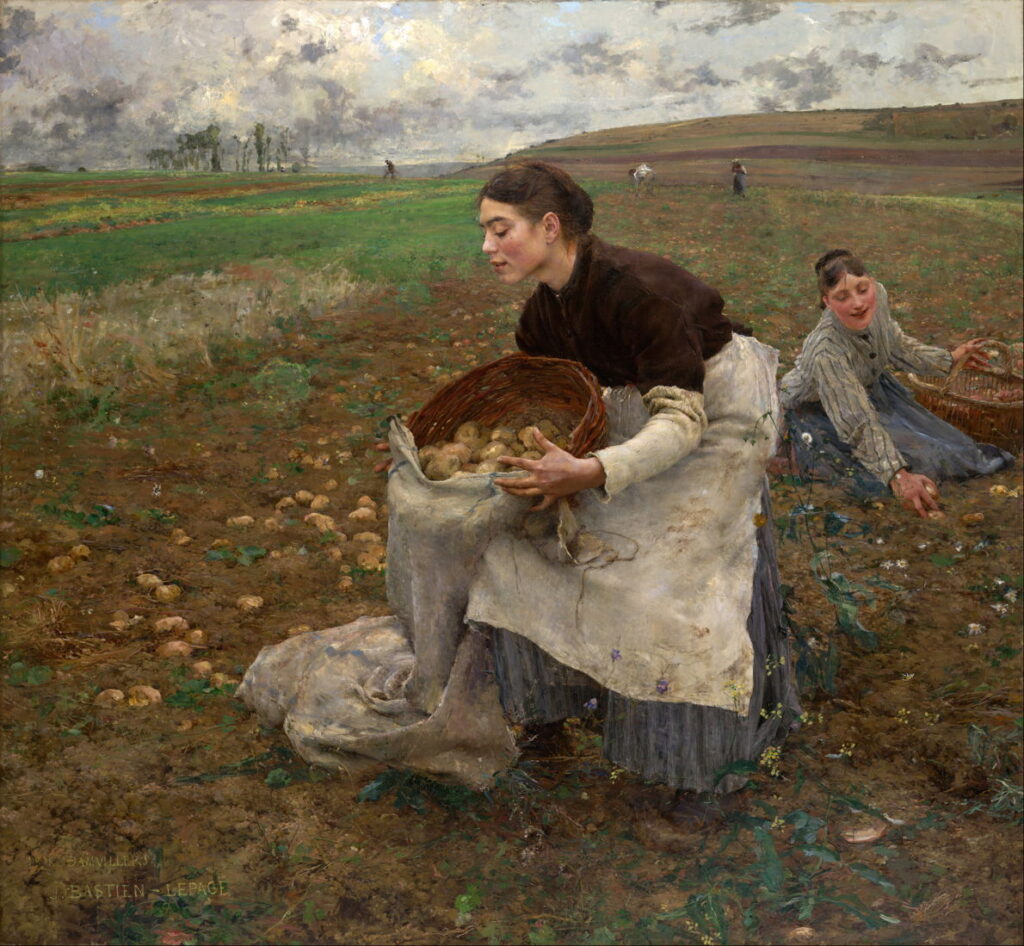The Real Country: Potatoes

One important staple crop has been largely forgotten from both agricultural and rural history: the humble potato. First imported from South America to Europe in the latter half of the sixteenth century, for the first couple of centuries it was considered exotic eating. It quietly became increasingly important during the eighteenth century, and is now widely credited as the food that enabled the population boom in much of Europe in the nineteenth century.
For several years from 1845, a fungus-like organism late blight caused widespread crop failure in the poorer parts of Ireland, Scotland and elsewhere, causing the Great Irish Famine, with at least a million dying from starvation.
The potato is unusual for storing large amounts of starch in its tuber. Although starch is only about one fifth of the potato by weight, the remainder being water, it came be the staple food for much of the working population, in both country and city. Overton has calculated using estimated crop yields from the early nineteenth century that an acre of potatoes would have provided about 2.5 times as many calories as an acre of wheat.
Like wheat, growing potatoes is a process of amplification. Tubers from the previous crop are sown in the ground, and multiply to yield many times the weight originally sown. Production is thus not dependent on conventional seed, but on seed potatoes with a more limited life. If a whole crop is destroyed by blight, not only is there nothing to eat that year, but the seed potatoes for the following year are also lost. Blight remains in the soil, and once affected that land has to be used for crops other than potatoes.
However, potatoes had other advantages in a war-torn and taxed Europe. While troops rampaging in foreign countryside would often raid or burn fields of grain, damaging or stealing potatoes proved more resistant to invaders. They were also likely to escape taxes or charges levied on other arable crops.
During the eighteenth century, labourers fortunate enough to have a little land they could farm for themselves started to grow potatoes, to supplement their limited diet. Small potato patches sprung up in the countryside, and around towns. Production at scale remained unusual until the following century, when some English counties including Lancashire and Middlesex devoted significant areas to supply the growing cities. That in turn depended on transport such as canals and then railways to deliver sacks of potatoes to urban consumers.
Vincent van Gogh (1853–1890), Still Life with Potatoes (September 1885), oil on canvas, 47 x 57 cm, Museum Boijmans Van Beuningen, Rotterdam, The Netherlands. Wikimedia Commons.
When Vincent van Gogh was living in Borinage in Belgium, he was among labourers whose staple food was potatoes, in one of the areas that had grown them for longer than most. His Still Life with Potatoes, painted in September 1885, is his tribute to the humble vegetable.
Potato production was painted extensively by social realists including Jean-François Millet, in the middle of the nineteenth century.
Jean-François Millet (1814–1875), Potato Planters (c 1861), oil on canvas, 82.5 x 101.3 cm, Museum of Fine Arts Boston, Boston, MA. Wikimedia Commons.
Millet shows this back-breaking work in his Potato Planters from about 1861.
Jean-François Millet (1814–1875), The Potato Harvest (1855), oil on canvas, 54 x 65.2 cm, Walters Art Museum, Baltimore, MD. Wikimedia Commons.
The Potato Harvest from 1855 is another more substantial work developed from Millet’s drawings. In the foreground, a man and woman are working together to fill sacks with the harvested potatoes, to be loaded onto the wagon behind them. The other four work as a team to lift the potatoes using forks and transfer them into wicker baskets, a gruelling task. Although the fields in the left distance are lit by sunshine, the dark scud-clouds of a heavy shower fill the sky at the right. Being poor, none of the workers has any wet-weather gear. The soil is also poor, full of stones, and yields would have been low despite the full sacks shown at the right.
Jean-François Millet (1814–1875), L’Angélus (The Angelus) (1857-59), oil on canvas, 55 x 66 cm, Musée d’Orsay, Paris. Wikimedia Commons.
Millet’s most famous single work, The Angelus, was completed around 1857-59. This had been commissioned by the American collector Thomas Gold Appleton, as Prayer for the Potato Crop, but underwent modification before Millet renamed it. At some stage, it’s thought to have included a child’s coffin, but that was overpainted.
It shows a couple, praying the Angelus devotion normally said at six o’clock in the evening, over the potatoes they have been harvesting. It’s dusk, and as the last light of the day fades in the sky, the bell in the distant church is ringing to mark the end of work, and the start of the evening. Next to the man is the fork he has been using to lift potatoes from the poor, stony soil; his wife has been collecting them in a wicker basket, now resting at her feet. Behind them is a basic wheelbarrow with a couple of sacks of potatoes on it, ready to be taken home.
Jules Bastien-Lepage (1848–1884), October: Potato Gatherers (1878), oil on canvas, 180.7 x 196 cm, National Gallery of Victoria, Melbourne. Wikimedia Commons.
Twenty years later, Jules Bastien-Lepage painted what’s now sometimes known as October or Potato Gatherers (1878), but was originally shown as October: Potato Gatherers.
Vincent van Gogh (1853–1890), Woman Lifting Potatoes (1885), oil on canvas, dimensions not known, Van Gogh Museum, Amsterdam. Wikimedia Commons.
Vincent van Gogh painted Woman Lifting Potatoes (1885) and similar scenes during his time living with his parents in Nuenen, in North Brabant, the Netherlands.
János Pentelei Molnár (1878–1924), The Potato Harvest (1901), oil on canvas, 79 x 109 cm, Private collection. Wikimedia Commons.
János Pentelei Molnár’s The Potato Harvest from 1901 takes this theme into the early years of the twentieth century, in Hungary.
Laurits Andersen Ring (1854–1933), A Man Digging Potatoes (1901), oil on canvas, 86 x 67.5 cm, Statsministeriet, Copenhagen, Denmark. Wikimedia Commons.
Laurits Andersen Ring’s A Man Digging Potatoes from 1901 is pure social realism, as this smallholder uses his spade to lift the potatoes that are his staple diet. I believe that the plants shown here have suffered from potato blight, which also swept Europe periodically causing more famine and death.
Léon Frédéric (1856–1940), The Three Sisters (1896), oil on canvas, dimensions not known, Private collection. Wikimedia Commons.
Although the girls shown in Léon Frédéric’s Three Sisters from 1896 are clean and well dressed, they’re sat together peeling their staple diet of potatoes in a plain and barren farmhouse. A glimpse of the shoes of the girl at the left confirms that they’re neither destitute nor affluent.
Vincent van Gogh (1853–1890), The Potato Eaters (1885), oil on canvas, 82 × 114 cm, Van Gogh Museum, Amsterdam, The Netherlands. Wikimedia Commons.
Vincent van Gogh’s The Potato Eaters (1885) is another revealing insight into the lives of poor labourers in Nuenen, who are about to feast on a large dish of potatoes under the light of an oil lamp.
Émile Friant (1863–1932), The Frugal Meal (1894), oil, dimensions and location not known. Wikimedia Commons.
Émile Friant’s The Frugal Meal (1894) continues the social theme, as a poor family with four daughters sits down to a meal consisting of a bowl piled high with potatoes, and nothing else. More worryingly, the pot on the floor at the left is empty.
Further reading
Christopher Shepherd’s brilliant essay on the history of the potato in The Oxford Handbook of Agricultural History (2024), ed. Jeannie Whayne, Oxford UP, ISBN 978 0 19 092416 4.


